B2-Adrenergic Receptor Redistribution in Heart Failure Changes cAMP Compartmentation
And an Introduction to: Nanoscale live-cell scanning ion conductance and fluorescence resonance energy transfer microscopy
I read an article a few years back called "B2-Adrenergic Receptor Redistribution in Heart Failure Changes cAMP Compartmentation" and decided to share the findings it contains with everyone today. So this will also be a new concept of introducing an article along with the main methods used, I hope you shall like it!
The methods used here are really interesting, specially FRET, frequency resonance energy transfer, which is based on 3 different quantum models and makes for a nice presentation along with an medically important discovery.
I will start by introducing FRET & Scanning ion-conductance microscopy along with cardiomyocytes and the B1 and 2-Adrenergic Receptors. Then I will take you through this interesting article, which reports to have found a direct biochemical mechanism that causes heart failure.
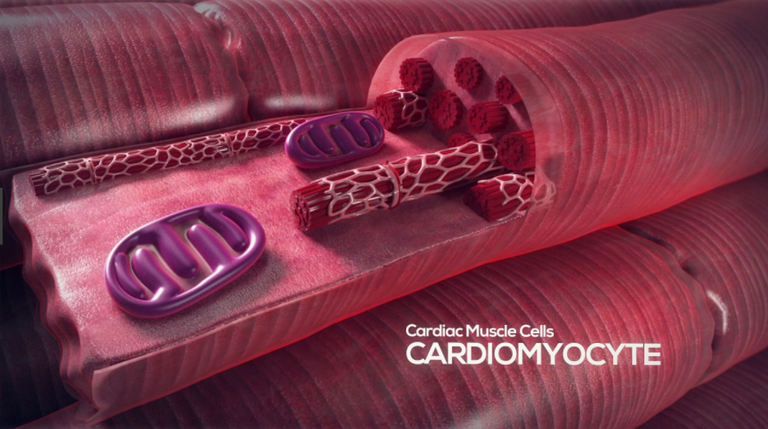
First of all, what is cardiomyocytes and B1 ans 2-Adrenergic Receptor?
Beta 1 or 2-androgenic receptors, ADRB1 / 2 or B1 /2 for short, is a common protein in automatically functioning muscle cells like the ones we have in the digestive track or heart. Passively beating muscle cells with other words. The ADRB receptors are located on the outside of the cell membrane and are also coupled to a G-protein, called Gs. The g-protein activates adenyl cylase inisde the cell, which activates cyclic-AMP or cAMP which then activates PKA, which induces e.g a calcium releasing chain reaction leading to e.g smooth muscle relaxation. Just to be clear, there are many other g-protein signaling pathways but they all have external receptors which leads to internal cascade responses.
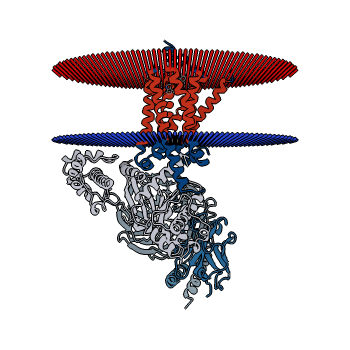

This is an important signal pathway for the cardiomyocytes, and ADRB1/2 reacts to epinephrine or adrenaline, an signal hormone, and induces an fight or flight response, as we all sure have felt.
Fluorescence frequency energy resonance transfer, FRET
Now its time to take a look at Fluorescence frequency energy resonance transfer, a very effective method for measuring extracellular binding mechanism in real time and in living cells! To be able to set up experiments like this is very important for engineers in biochemistry like my self.
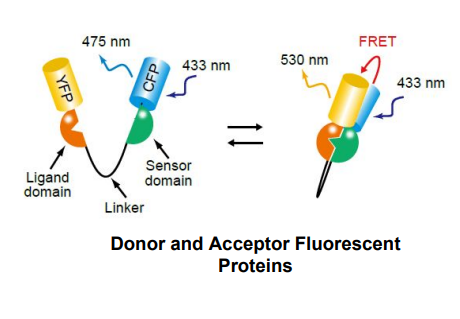
Frequency energy resonance transfer, is based on absorption and emission wavelengths of atom models or proteins. This spefific study uses a combination of CPF, cyano fluoresent protein and YFP, yellow fluoresent protein with a cAMP binding linker region. When the proteins is in close proximity of each other, the CFP will absorb light and then emitt it in a lower wavelength, in accordance with quantum models, energy will be lost to rotational and vibration energy. The emitted light with, now lower energy, will be absorbed by the YFP instead, and when YFP finally emits the light, it will be of a lower wavelenght, compared to if CFP emitted it directly. Then we can easaliy map the ratio of emission from CFP/YFP, which will indicate how much cAMP have bound to the linker regions. The ratio will be lowered with binding, since cAMP will sit in the middle of the proteins, distance them from each other, prevent FRET, and we will lose the signal from the YFP.
Nano pipette Scanning ion-conductance microscopy, SICM
The nanoscale scanning ion-conductance procedure uses a nano pipette to pressure against the tissue or cells, then applying a B1 or B2 selective stimulant, while simultaneously measuring changes in the FRET signal This will reveals the cell topology and receptor placement as the FRET ratio change upon successful receptor stimuli.
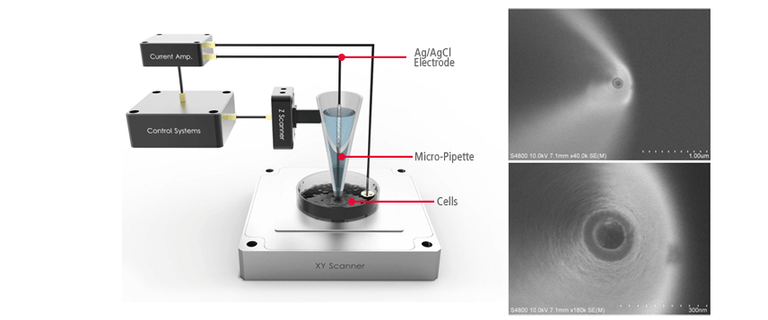
Scanning ion conductance microscopy is a imaging method working on nano scales. The tip of the pipette is pressured against the cell culture in buffer, and a voltage is applied. The voltage conduction will change depending on the topology of the cell. It will distinguish between tubuli, crests and other topological features down to an accuracy of nano meters. Both SICM and FRET works well on living cell culture and makes for a very good combination for imaging intra-cellular mechanisms in real time!
The Article: B2-Adrenergic Receptor Redistribution in Heart Failure Changes cAMP Compartmentation
In this article the links between B2-adrenergic receptor localization, cAMP compartmentation and risk for heart failures will be investigated by a combination of methods. The location of the Beta receptors have previously been unknown, but their function in regard to maintaining regular heart function is well studied so the group started with mapping the topology and receptor positioning of the cardiomyocyte.
This was done with nanoscale live-cell scanning ion conductance combined with FRET, frequence energy resonance transfer.
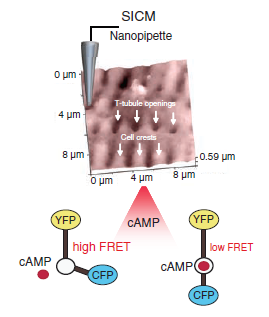
The YFP-linker-CPF, with a cAMP binding linker, were expressed in mice to enable this procedure. Using an inhibitor of B1 while measuring B2 signals and vice versa, as well as eliminating non specific binding via blocking both receptors with at least two chemically different inhibitors, then stimulating the blocked receptors to search for off site binding, or non specific binding as it is called, is standard procedure here.
This study used ICI to stimulate B1 and GCP to stimulate B2 receptors when performing the nanoscale scanning.
After comparing the results of healthy cell responses to the procedure with the response from cells taken from the transgenic mice with chronic heart failures, an change in receptor response where seen. B2 receptors where now signaling activity by activating the coupled g-protein mechanism and releasing cAMP, on the whole cell surface, crests and tubuli, compared to only tubuli in healthy cells. B2 receptors seem to move out of the tubuli.
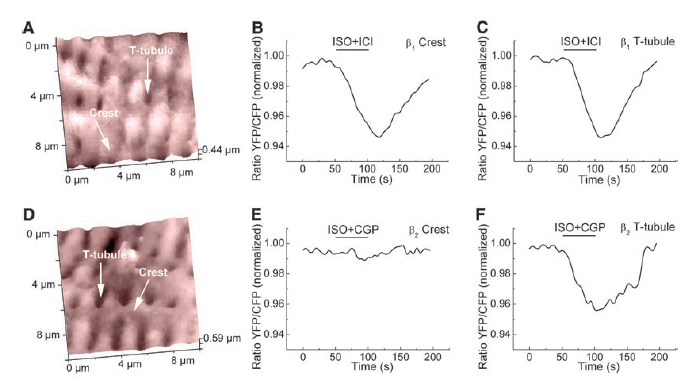
Seen above, data from SICM/FRET tandem experient of healthy cardiomyocytes from mice. This mainly functions as a template or control to match against the data from transgene mice
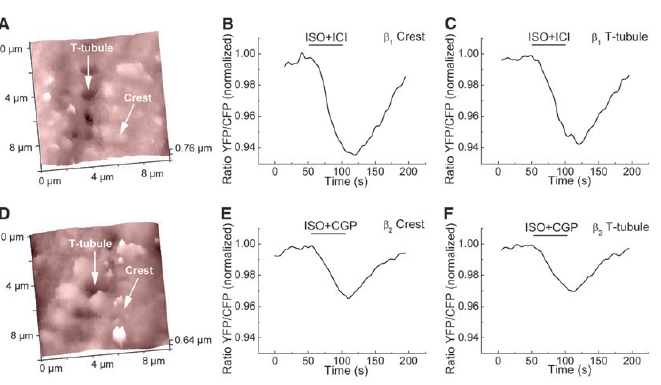
Seen above, data from SICM/FRET tandem experiment of cardiomyocytes from trasngene mice with chronic heart failure. A&D clearly show lost topology, mainly affecting t-tubuli. We can also see response from ADRB2 receptors on crest regions, proving dis localization from tubuli regions.
Interestingly enough, they also reported that topology changed, and less t-tubuli formed in the transgene cardiomyocytes, which is considered an signature mark of failing heart cells, or chronic heart failure rather.
Next the team decided to look at FRET ratio in different regions, when stimulating B2 receptors. In a healthy cell, the B2 activation, will release cAMP and activate PKA locally, since it is anchored to the complex in the tubuli. If the signal is spread through the cell, it will minic b1´s signal transduction and cause a heart failure, since B2 have a very important regulatory factor in cardiomyocyte contractions.
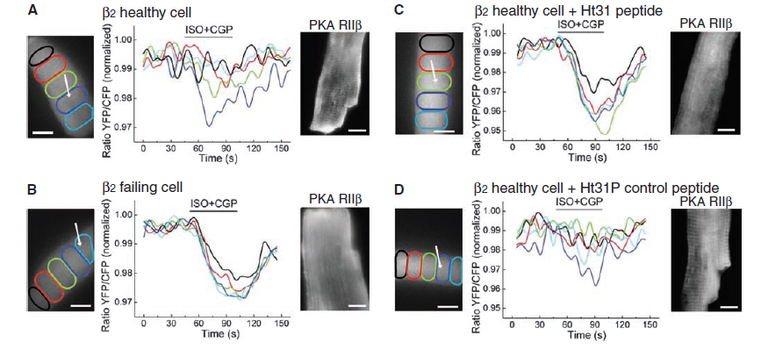
We can se that the ADRB2 signal from healhy cells with Ht31 present, mimics ADRB1 signals. They are not localized to the tubuli any longer and the signals will affect the full cytoplasm and fail in its maintaining function of the heart beat.
Ht31 dislocates PKA from the tubuli zone, which directly proves that the sick cells suffer from decoupling from the g-protein when dislocated from tubuli zones. Healthy cells with Ht31 peptides give identical signals to the sick cells. giving this direct insight.
The experiment revealed, as expected decoupling of PKA from the tubulin will lead to cAMP spreading through the full cytoplasm, like B1 signals. The finding was verified using Ht31 in healthy cells, as well as a control funt with ht31P. Ht31 decouples or anchors PKA, and disrupts the rapid local breakdown of the cAMP signal, and the results indeed verify that decoupling of PKA from the complex in t-tubuli is a major factor.
The study also inhibited PEDs with IBMX to rule out cAMP degradation by phosphodiesterases, and only a slight change in intensity but no difference in propagation of the signal throughout the cytoplasm.
The team now knew that B2 receptors dislocate from tubuli and that this will result in decoupling form the PKA “pool”, resulting in signals that reverberate throughout the full cytoplasm. The dislocation of B2 from tubulin to crest regions has also been linked to low cholesterol levels at the cell surface, cholesterol deficiency will displace the B2 receptor but tubulin will be intact, linking it directly to B2 localization.
In summary, using the SICM-FRET technique, we were able to functionally localize
b1ARs and b2ARs to the surface structures of adult ventricular cardiomyocytes and to uncover
the mechanisms leading to the abnormal cAMP compartmentation in heart failure. These findings
should provide a deeper understanding of this cardiac disease and facilitate the development
of new therapeutic strategies.
These finding will enable more precise therapeutic methods, since the exact mechanism of signal disruption leading to heart failure , was previously unknown.
Nikolaev, V. O., et al. (2010). "β2-adrenergic receptor redistribution in heart failure changes cAMP compartimentalization." Science 327: 1653-1657.
https://www.ncbi.nlm.nih.gov/pubmed/20185685
Park Scanning Ion Conductance Microscopy
http://www.parkafm.com/index.php/component/content/article/107-park-afm-technology/261-park-sicm
Scanning ion conductance microscopy: a convergent high-resolution technology for multi-parametric analysis of living cardiovascular cells
Michele Miragoli, et al.
http://rsif.royalsocietypublishing.org/content/8/60/913
Protein data base ADRB2 Image
https://www.rcsb.org/structure/3SN6
Adrenaline Image
https://sv.wikipedia.org/wiki/Adrenalin
Previous Episodes on Genetics & Proteins:
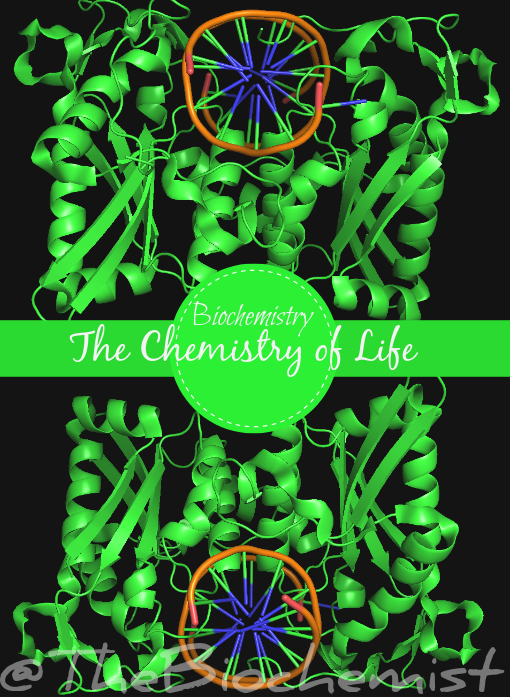
Life science reviews:
Epigenetic effects of arsenic exposure
Fascinating genetics:
The Polymerase chain reaction
Telomere & telomerase
Retrotransposons
Fascinating proteins:
Aquaporines
ATPsyntase
The Prion protein
Amyloid precursor protein, APP & Alzhemier
Cloning vectors, The Plasmid
Short news on:
Dangers of glyphosate
Cancer progression from arsenic exposure
Very educational
Thanks for checking in :)
Very interesting!!
Thanks for checking it out :)
You never stop, :-o
Did you back this up with some bots?
I wonder if somebody ever tried injecting music into the diseased area.
A tiny speaker, some Bach, some Hendrix. Enjoy tis video
https://www.bing.com/videos/search?q=Randy+Powell+introduction+to+vortex+mass&input=2&nclid=DAC6EE48686C348F097F76E9B68E45A6&cc=US&setlang=en-US&sbts=-1&ru=%2fsearch%3fq%3dRandy%2bPowell%2bintroduction%2bto%2bvortex%2bmass%26input%3d2%26nclid%3dDAC6EE48686C348F097F76E9B68E45A6%26FORM%3dWNSBOX%26cc%3dUS%26setlang%3den-US%26sbts%3d-1&view=detail&mmscn=vwrc&mid=DC09F001907EDBF013EDDC09F001907EDBF013ED&FORM=WRVORC
Hmm, I'll have to blog it .
Hey! Nice to see you here :) Hehe yeah music therapy sounds nice, you should check it out along with bioresonance.
I´ve actually seen this video a while back, and some other content on vorext maths, havent found a puropse for it yet thou, might be a result to my lack of understanding, might be worth looking at again :)
Peace bro!
I never left, I've been checking for your next blog for five days. Now I can get some sleep tonite.
Did you see the water memory video? I might post that one too.
Ah :) yeah been working a lot as well :/.
Yeah seem to be some ecidence of water memory just that it does not sound thermodynamicaly stabile, I must read more about it, and the old DNA teleportation experiment :)
Peace
Interesting news, nicely presented. Precise localisation of the receptors will be helpful in finding the new therapeutic agents for heart failure.
Yes indeed, precise knowledge of the underlying biochemical helps a lot in designing the agenst :)
Thanks for checking it out!
Peace
As a follower of @followforupvotes this post has been randomly selected and upvoted! Enjoy your upvote and have a great day!
How nice :) Thanks!
GREAT BLOG, very good work, I thank you.
Thank you for checking in :) always great to see you!
Great stuff!
Indeed a great article, but hard to comprehend without some background on the methods and insight in the data :)
Thanks for reading!
You got a 6.54% upvote from @upmyvote courtesy of @clausewitz!
If you believe this post is spam or abuse, please report it to our Discord #abuse channel.
If you want to support our Curation Digest or our Spam & Abuse prevention efforts, please vote @themarkymark as witness.
This post is qualified for a resteem by the Abasinkanga Resteem Service
Check out Abasinkanga Resteem Service - FAQ (Frequently Asked Questions) for full details about this service
I am not a bot. Upvote this comment if you like this service.